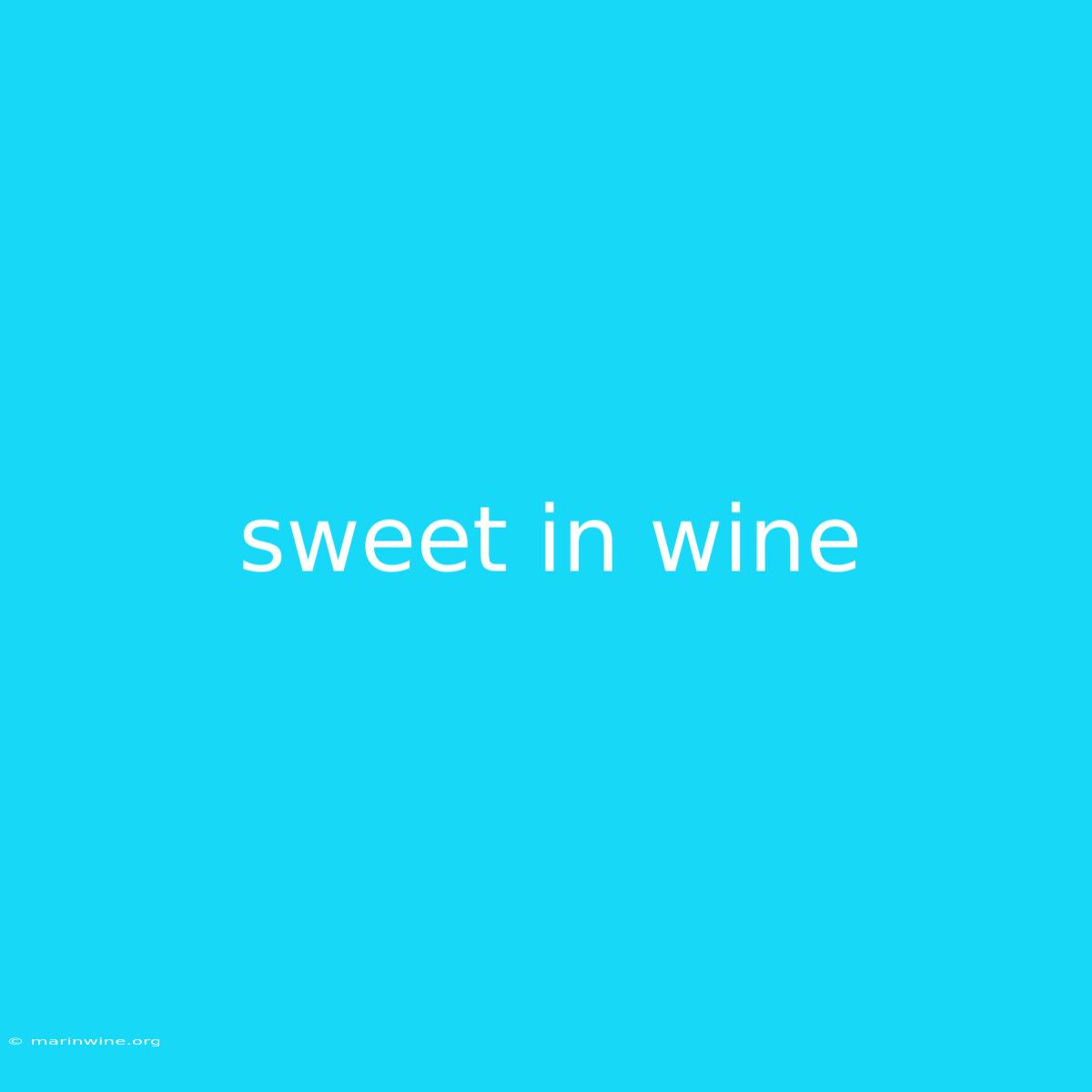The Sweetness in Wine: Unveiling the Secrets of Dessert Wines
Have you ever wondered what makes certain wines taste so lusciously sweet? It's not just added sugar – it's a fascinating interplay of natural sugars, yeasts, and the art of winemaking.
Why It Matters: Understanding the sweetness in wine can elevate your enjoyment, guiding you towards perfect pairings and deepening your appreciation for this complex beverage. This guide will explore the different types of sweet wines, the factors contributing to their sweetness, and how to savor them best.
Key Takeaways of Sweet Wine:
| Category | Description |
|---|---|
| Types | Dessert, Fortified, Sparkling, Still |
| Sweetness Level | Dry, Off-dry, Medium-sweet, Sweet |
| Taste Profiles | Fruity, Floral, Spicy, Herbal |
| Food Pairings | Desserts, Cheeses, Spicy Foods, Fruits |
Sweet Wine: A Journey of Taste
Introduction: Sweet wines are more than just a sugary treat. They offer a range of complex flavor profiles, from the delicate sweetness of Riesling to the intense richness of Sauternes.
Key Aspects of Sweetness in Wine:
- Residual Sugar: This refers to the sugar left behind after fermentation. The less residual sugar, the drier the wine.
- Botrytis cinerea (Noble Rot): A fungus that dehydrates grapes, concentrating their sugars and flavors, leading to exceptionally sweet wines.
- Fortification: Adding brandy or other spirits during fermentation stops the yeast from converting all sugar into alcohol, resulting in a sweet, fortified wine.
- Grape Variety: Certain grapes, like Muscat, Riesling, and Gewürztraminer, naturally possess high sugar content.
Botrytis cinerea: The Magic of Noble Rot
Introduction: Botrytis cinerea, or "noble rot," is a fascinating phenomenon that dramatically alters the taste of wine.
Facets of Botrytis cinerea:
- Impact: It dehydrates the grapes, concentrating their sugar and flavor compounds.
- Appearance: Creates a "shriveled" appearance on the grapes.
- Flavor Profile: Leads to a rich, honeyed sweetness with notes of apricot, citrus, and sometimes, a hint of ginger.
- Region: Notable in regions like Sauternes (France) and Tokaji (Hungary).
- Risks: Can be difficult to control, leading to potential spoilage if not managed carefully.
Sweet Wine Pairing: A Delicious Harmony
Introduction: Pairing sweet wines with food can create delightful experiences.
Further Analysis:
- Desserts: Sweet wines are natural partners for desserts, especially those with rich, creamy textures.
- Cheeses: Blue cheeses and other strong cheeses are complemented by the sweetness and acidity of dessert wines.
- Spicy Foods: The sweetness of dessert wines can balance the heat of spicy dishes.
- Fruits: Fresh fruits like berries, pears, and apples are ideal for pairing with sweet wines, creating a refreshing contrast.
Information Table: Sweet Wine Styles
| Style | Characteristics | Examples |
|---|---|---|
| Dessert Wines | Made from late-harvest grapes or grapes affected by botrytis. | Sauternes, Tokaji, Ice Wine |
| Fortified Wines | Wine with added brandy or other spirits. | Port, Sherry, Madeira |
| Sparkling Wines | Sweet or semi-sweet, often with a fruity profile. | Moscato d'Asti, Asti Spumante |
| Still Wines | Made from sweet grapes or with added sugar. | Riesling, Gewürztraminer, Muscat |
FAQ: Sweet Wine
Introduction: Let's address some frequently asked questions about sweet wine.
Questions:
- Q: Is sweet wine unhealthy? A: Sweet wines are often lower in alcohol than dry wines, and they can be enjoyed in moderation as part of a balanced diet.
- Q: How can I learn to taste sweet wine? A: Focus on the aromas and flavors, identify the different layers of sweetness, and explore various styles to discover your preferences.
- Q: Are all sweet wines expensive? A: While some are high-end, there are many affordable options available. Explore different regions and varieties to find your favorites.
- Q: How can I tell if a wine is sweet? A: Look for terms like "dessert," "late harvest," "botrytis," or "fortified" on the label.
- Q: How do I store sweet wine? A: Sweet wines, particularly fortified wines, have a longer shelf life. Store them in a cool, dark place.
- Q: Can I make my own sweet wine? A: Yes! Home winemaking can be a rewarding hobby. Start with simpler recipes and learn the techniques over time.
Tips for Enjoying Sweet Wine:
Introduction: Here are some tips to elevate your experience with sweet wines:
Tips:
- Chill It: Most sweet wines benefit from being chilled, especially sparkling and dessert wines.
- Pay Attention to Aroma: Sweet wines often have enticing aromas; take time to savor them before taking your first sip.
- Experiment with Pairings: Don't be afraid to try different food pairings to find what you enjoy most.
- Learn the Terms: Familiarize yourself with wine vocabulary, particularly terms like "residual sugar" and "botrytis."
- Explore New Regions: Travel the world through wine! Discover sweet wines from different regions to expand your palate.
Summary of Sweet Wine:
The world of sweet wine is vast and flavorful. By understanding the factors that create sweetness, exploring different styles, and practicing mindful tasting, you can unlock a world of delicious discoveries.
Closing Message: Sweet wine is more than just a sugary treat; it's a journey of taste, a celebration of nature's gifts, and an opportunity to explore the multifaceted world of wine. Embrace the sweetness, savor the experience, and let your palate guide you on this delightful adventure.

